| ANCIENT HISTORY | ||||
|---|---|---|---|---|
| The Neolithic Age | The Bronze Age | The Iron Age | The Late Pre-Islamic Age | |
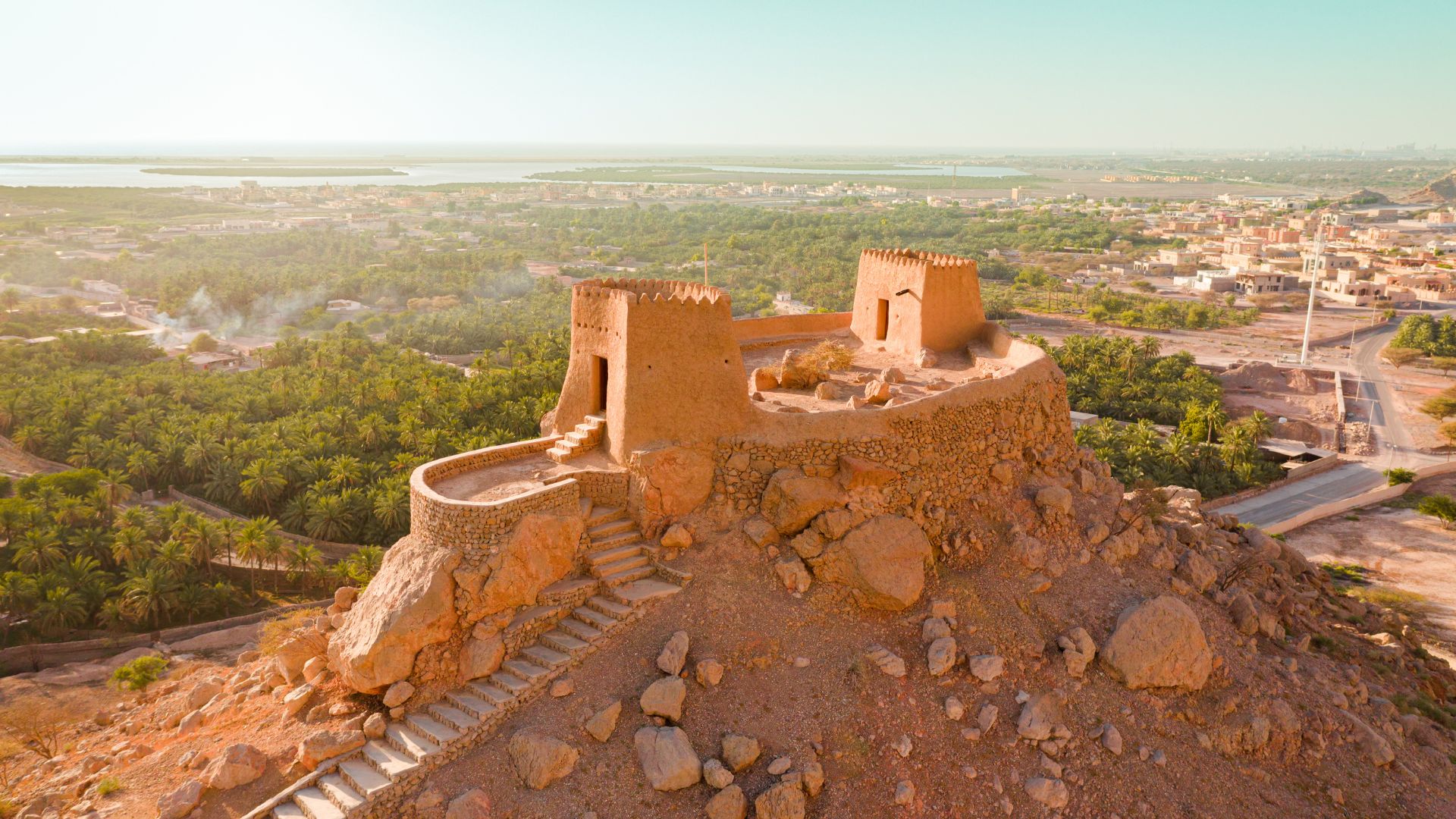
Ras Al Khaimah’s rich past consists of over 7,000 years of continuous human activities, covering all archaeological and historical periods. A unique geographical combination of high rising mountains, fertile plains, lagoons and the Arabian desert created a diverse environment for human settlement.
THE NEOLITHIC AGE
Twenty-three kilometres south-west of the modern city of Ras Al Khaimah, near the abandoned fishing town of Jazirat al-Hamra, lies a small, partly destroyed shell mound. Essentially a heap of prehistoric domestic waste known as a shell midden, it consists mostly of fish bones and mollusc shells, as well as fragmentary remains of dugong and livestock bones. It is of little interest to tourists and passers-by, and yet is of immense value to the understanding of Ras Al Khaimah’s ancient past.
When the site was first identified by German archaeologists in the late 1980s, fragments of Mesopotamian pottery dating from the Ubaid Period were found among the heap of fish bones and mollusc shells. Their presence meant the mound was of Neolithic origin and could be dated to the fifth or sixth millennia BC, indicating that the ceramic shards were among the oldest pieces of pottery ever found in the lower Gulf. They also provided evidence that Ras Al Khaimah could trace its history back at least 7,000 years.
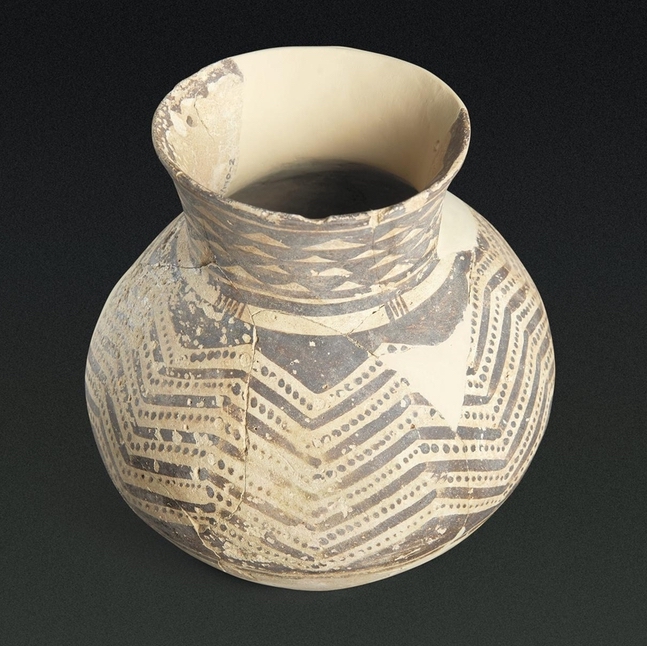
Pottery from the Ubaid Period were decorated with a dark brownish paint. © Mark Beech
The distinctive nature of Ubaid pottery, with its geometric design and the use of dark paint on a cream base, has helped with its identification at other sites across the country. Similar discoveries have been made along the coast in Umm Al Quwain and Sharjah, as well as on several islands off the coast of Abu Dhabi. Together, they contribute to a growing, if limited, understanding of Neolithic life in Ras Al Khaimah.
Very little is known about the people who inhabited the emirate 7,000 years ago, although a much clearer picture has been painstakingly pieced together over the course of the past thirty years. Along the coast, they occupied seasonal settlements, living largely as fishermen and hunters. The discovery of large quantities of fish, dugong, turtle and dolphin bones suggest that seafood was their primary source of food, although the presence of other bones indicates that they practiced animal husbandry too. The fragments of Ubaid pottery discovered at Jazirat al-Hamra also reveal the existence of maritime trade, although the full extent of that trade remains unknown.
Inland, the people were primarily nomadic, or semi-nomadic, pastoralists who herded cattle, sheep and goats. They hunted animals such as gazelle with weapons made of flint and other stones, and they roamed a land that was much greener than it is today. The discovery of arrowheads, scrapers, knives and borers at sites across the UAE, as well as flakes (a type of stone tool) and blades made from different kinds of flint at the shell midden near Jazirat al-Hamra, reveal the existence of sophisticated tools. Similar flint items dating from the same era have also been found at sites near the village of Khatt, including a manufacturing place with unfinished or broken tools. These include a chopper, an adze (similar to an axe), wedge, two small broken arrowheads and several scrapers, piercers and blades. All would have been used for a variety of hunting, gathering and sedentary purposes.
As hard as it is to imagine now, the climate would have been far friendlier 7,000 years ago. There were freshwater lakes and grasslands for livestock, as well as extensive seagrass meadows that were suitable for dugong and other marine life. The landscape of Ras Al Khaimah was also unique (as it is today), thanks to its remarkable combination of sea, mountains and fertile plains, all of which provide invaluable resources for those who chose to live there.
No other remnants of the Neolithic Age have yet been discovered, leaving only a few tantalising traces of human existence. An existence that would not come into sharper focus until the arrival of the Bronze Age.
THE BRONZE AGE
It was during the Bronze Age that the first inklings of a more sophisticated culture began to emerge. Traditionally divided into four separate periods, the Bronze Age stretched from the Hafit Period of the late fourth and early third millennia BC, to the Umm an-Nar (2600–2000 BC), the Wadi Suq (2000–1600 BC) and the Late Bronze Age (1600–1250 BC) cultures that came to dominate what is now the UAE and northern Oman.
The first three periods are named after the locations where evidence of their existence was first discovered. In the case of the Hafit Period, that was Jebel Hafit in Al Ain. For Umm an-Nar, it was an island off the coast of Abu Dhabi with the same name, while for Wadi Suq, it was an eponymous valley located between Al Ain and the Oman coast. Due to the lack of historical evidence, the study of these periods has been entirely dependent on archaeology.
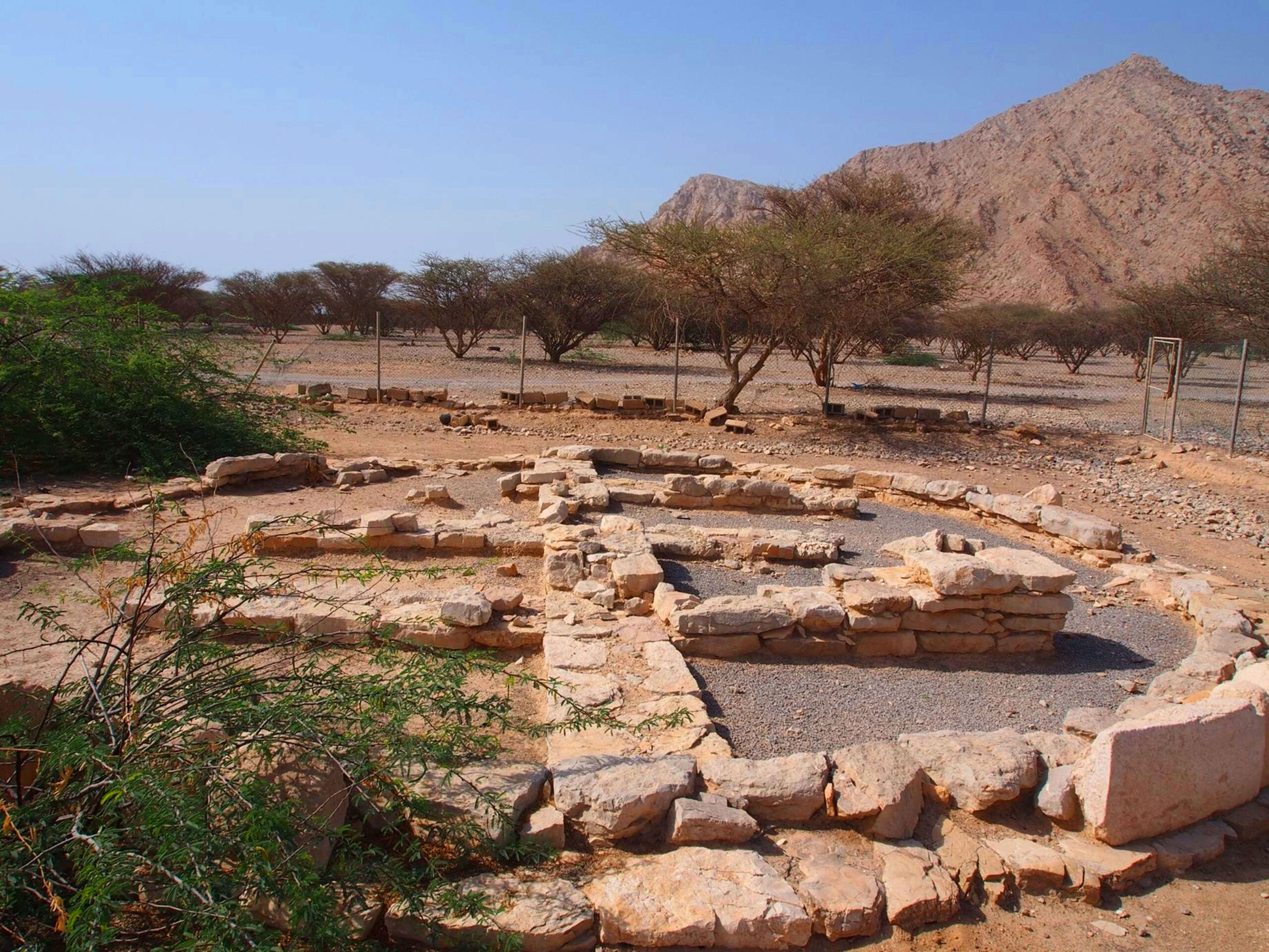
Prehistoric tomb in Ras Al Khaimah that dates back to the third millennium BC.
The Hafit Period (3200–2600 BC)
In contrast to the Neolithic inhabitants of Ras Al Khaimah, the Hafit Period is characterised by the evolution of oases settlements. Along the mountains of northern Ras Al Khaimah around Qarn alHarf and the village of Khatt, as well as in the valley of Wadi al-Qawr, more than 150 burial cairns have revealed traces of human existence dating back more than 5,000 years. Although very little is known of their day-to-day lives, the concentration of burial cairns indicates the presence of permanent oases settlements and semi‐nomadic pastoral groups that moved from one location to another.
Archaeological evidence for this period has been found at many locations, including two
outstanding places – Khatt and Qarn al-Harf. The former – a village renowned for its hot springs – is the oldest permanently inhabited area of Ras Al Khaimah, with evidence of human activity dating back to the Neolithic Period. The latter represents a solitary hill in front of the Hajar mountains between Wadi Bih and Wadi Naqab. First discovered by the British archaeologist Beatrice de Cardi in 1977, the burial cairns at Khatt are situated on the lower ridges east of the springs. Made from uncut or rough-cut local stone, the circular tombs would have had the outward appearance of a beehive and consist of a small burial chamber for between two and five people. Standing in some cases at a height of about two metres, they ranged from seven to nine metres in diameter and, although their internal construction was rarely visible, small central chambers were partially exposed. The majority had either collapsed or been plundered, although most shared common structural characteristics. Spread over an area of about one kilometre, they are concentrated on a small plateau and are similar to those found in Al Ain.
The largest cluster of Hafit cairns in Ras Al Khaimah was discovered by the Department of Antiquities and Museums in Qarn al Harf. More than sixty tombs are situated in small groups at the foot of the hill, as well as on top of its ridges. Their large number points to a major prehistoric settlement, which once must have existed in the oasis of Hail or Fahlain.
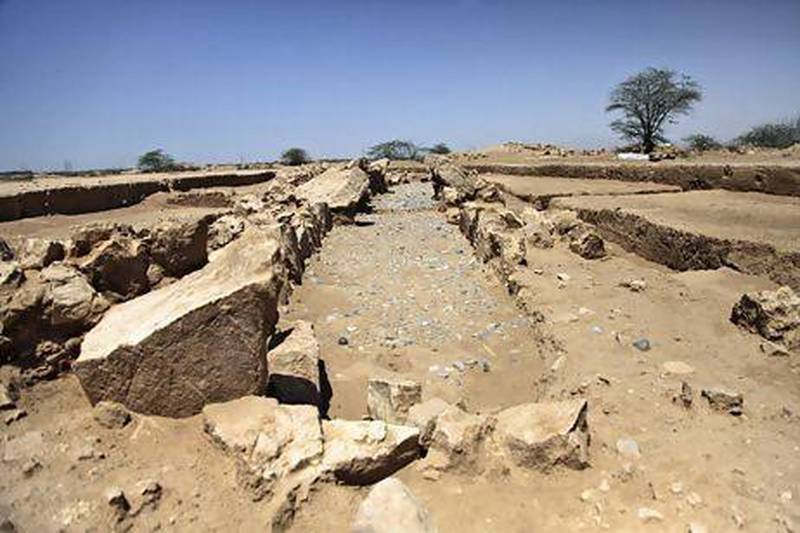
Wadi Suq tomb excavated in Qarn al-Harf. © Lee Hoagland / The National
The dating of these structures has been made possible by the discovery of pottery in a handful of the oldest of the Al Ain tombs. The findings have included decorated Mesopotamian pottery from the Jemdet Nasr Period (3100–2900 BC) and a collection of small, blue-green tubular beads, also from Mesopotamia (modern-day Iraq). As with the Neolithic Period, the discovery of pottery reveals the existence of a trading relationship between the upper and lower Gulf during the Hafit Period. Further dating evidence was discovered during recent excavations in Qarn al-Harf by the Department of Antiquities and Museums, which revealed sherds dating to the late Hafit/early Umm an-Nar Period.
Because most of the Hafit-era tombs have been looted, little to no information is available that can help with the production of a clear image of their occupants. Evidence of any other structures or settlements from this period have yet to be discovered in Ras Al Khaimah and the rest of the country.
Umm an-Nar Period (2600–2000 BC)
The Umm an-Nar Period has bequeathed Ras Al Khaimah some of its most spectacular archaeological discoveries. Nowhere is this more apparent than at Shimal, where two circular tombs represent the largest funerary Umm an-Nar structures ever found in south-east Arabia. Their sophisticated structure, as well as the large number of people buried there, reflect the importance of Ras Al Khaimah during the third millennium BC.
A dense archaeological landscape located about eight kilometres north-east of the modern city of Ras Al Khaimah, Shimal is a treasure trove of prehistoric tombs. It is the emirate’s largest preIslamic site, not just in relation to the Umm an-Nar culture, but to all subsequent eras prior to the arrival of Islam. The existence of palm gardens, its favoured position at the foothills of the Hajar Mountains, as well as its easy access to a safe harbour and fertile hinterland meant Shimal was of extreme geographical importance. As many found, and would continue to find, the Hajar Mountains are endowed with the natural resources that were vital to the ancient economies of this region of Arabia.
The first of the two Shimal tombs was discovered by a German Mission from the University of Göttingen in 1987. As well as the remains of around 100 people, the tomb contained locally manufactured pottery, as well as pottery from Mesopotamia, Baluchestan, Bahrain, and the Indus Valley. It also hinted at the existence of large settlements supported by oasis agriculture, at the heart of which would have stood the cultivation of the date palm. The agricultural systems of the Umm anNar period – based on discoveries at other sites across the UAE, most notably at Hili in Al Ain – would have utilised either surface-water irrigation or the use of wells.
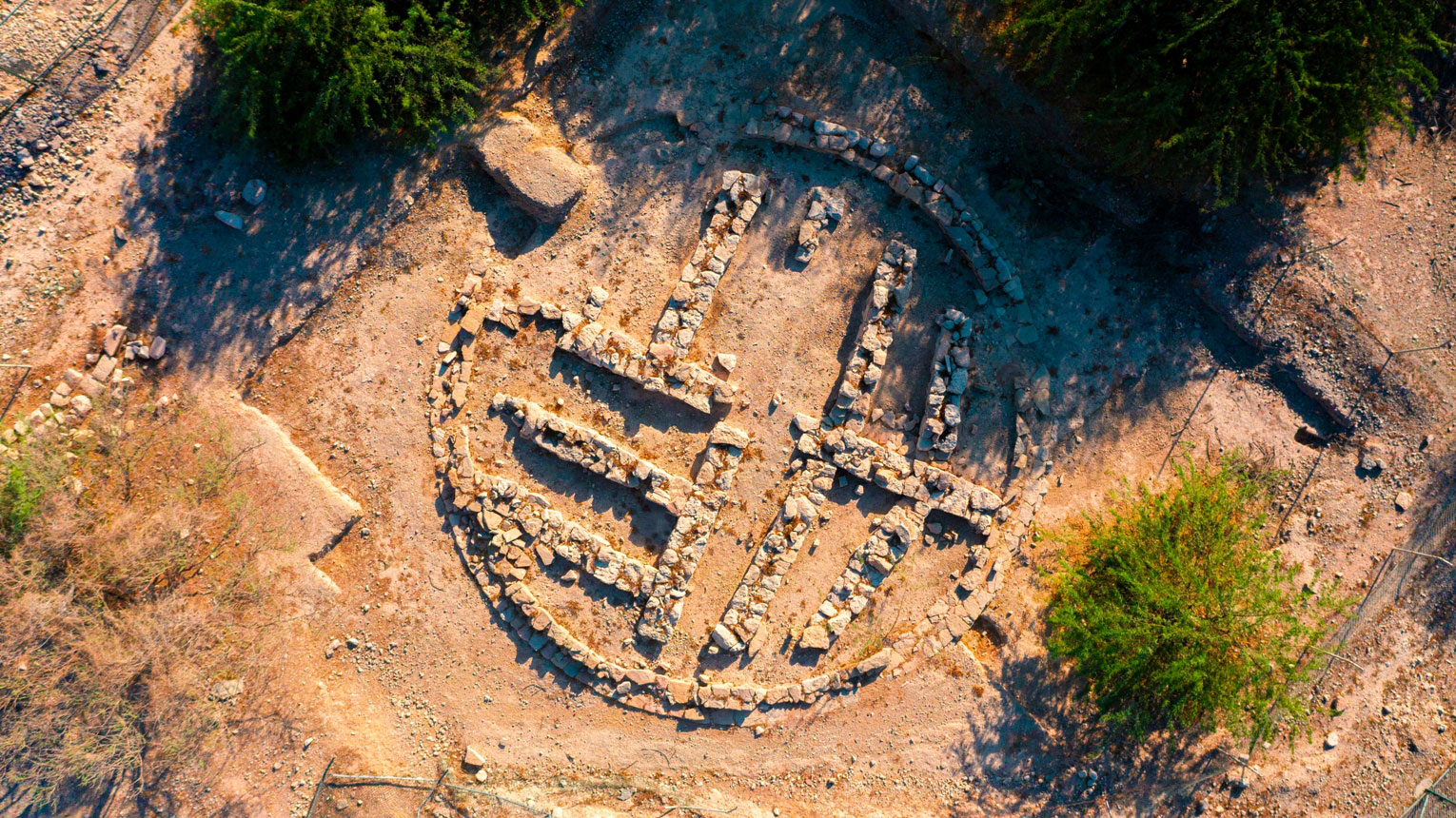
A large tomb from the Umm an-Nar Period in Shimal.
The second tomb, lying about 200 metres north of the first, was excavated in 1997 and 1998 by a team from Ras Al Khaimah’s Department of Antiquities and Museums. The largest known tomb of its kind in the UAE and Oman, the circular structure has a diameter of 14.5 metres and would have been used as a communal grave for either family or tribal members over an extended period of several generations. Although only the lower parts of the building remain, the tomb would have been between two and three metres in height and features twelve burial chambers divided by internal walls. In total, there were three grave units, each with matching entrances.
The outer walls of the tomb were erected on a plinth with two different faces forming the circular wall. On the inside would have been a layer of roughly hewn stones. On the outside, ashlar masonry cut from white limestone was shaped to match the curve of the tomb. This bright and smooth facing extended up to the roof, giving the impression of a large white tower. All entrances were closed with specially shaped stones, whose carved-out handles simplified the opening and closing whenever a new body had to be buried.
Complex burial rites appear to have taken place at both of the tombs. Initial internment on the cobbled floor was followed by the removal of bones and funerary goods, which were then burned and returned to the tomb and placed on shelves. As a result, hundreds of individuals could be buried along with a wide range of artefacts. All were originally buried in a flexed position, together with their personal belongings, such as pottery, jewellery, weapons and soft-stone vessels. Later they would be cremated to make way for further burials. This helps to explain the large number of burials, which is estimated to be in excess of 400. One woman was even buried with her pet dog.
Umm an-Nar tombs have also been discovered at numerous other sites across the emirate, including Wadi Muna’i and Asimah. At the latter, numerous significant artefacts were unearthed, including a bronze goblet, socketed spearheads and dagger blades. The discovery of fragments of storage jars from the Indus Valley Civilisation (in modern-day Pakistan and India) also suggests that goods were being exported to the Gulf in considerable quantity. At the large Umm an-Nar tomb at Shimal, for example, imported pottery accounted for 15 per cent of the total collection. This included Mesopotamian pottery from the Late Akkadian Period and Bampur and Kaftari pottery from the Baluchestan and Fars provinces of Iran. Black-on-grey and incised grey pottery from Iran was also discovered, as well as fragments from Harappa.
Evidence also indicates that copper was being shipped from the Lower Gulf to Mesopotamia and the Indus Valley. Mesopotamian texts describe trading relations with a region of the Arabian peninsula known as Magan, as early as the third millennium BC. Believed by historians to encompass an area now covered by the UAE and Oman, Magan was a valuable source of copper for the regional powers of the day. Mined in the Hajar Mountains, it was shipped in large quantities to cities in Mesopotamia and the Indus Valley, along with other goods such as timber and stone. Such trade contributed to the development of an increasingly sophisticated culture that straddled the important trade routes between the coastal and inland sites of Oman and those on the Emirati coast. The presence of such trade implies the existence of a seafaring tradition, with Mesopotamian texts also referring to “the ships of Magan”
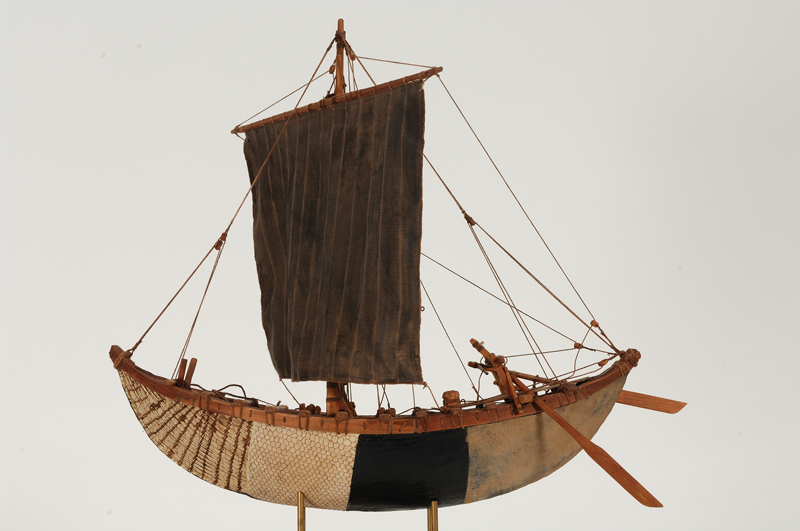
Model of a Magan boat. © The Office of the Adviser to HM the Sultan for Cultural Affairs, Oman.
Compared with previous eras, the quantity and quality of material evidence has enabled archaeologists to build a far more robust image of life in Ras Al Khaimah during this period. Communities from the Umm an-Nar Period would have relied on the cultivation of wheat, barley and dates, as well as the rearing of livestock such as sheep, goats and cattle. The hunting of land and marine life, depending on the location of the settlement, would have also been prevalent. There is also evidence of the development of a wide range of craft industries, including the production of soft-stone vessels and pottery, as significant quantities of locally produced fine red grave ware have shown, which were found in the large tombs at Shimal. It can be assumed that the exploitation and export of copper would have led to the creation of far more prosperous communities as a whole.
As well as large tombs for the dead, other elements of communal living began to appear elsewhere in the UAE, including large defensive towers at sites in Al Ain and Fujairah.
Wadi Suq Period (2000–1600 BC)
The transition from the Umm an-Nar to the Wadi Suq Period is a contested one. Although it is generally agreed that climate change began to transform the lives of those who inhabited the Arabian peninsula from around 2200 BC, the extent of that transformation is debated. Did it lead to a movement away from settled communities and a return to a more nomadic lifestyle? Or did settlements persist despite a major shift in climate? Whatever the answer, the transition took place over a period of more than 200 years.
What is certain is that the abrupt onset of drought conditions led to extreme aridity and a dramatic change in the landscape. Why this environmental event occurred is not known, but it contributed to the downfall of the Akkadian Empire in Mesopotamia, the abandonment of towns and cities, and the migrations of people. Such widespread disruption would have led to conflict and a breakdown in regional trade. In Mesopotamia, the drought is believed to have lasted for over 300 years, while the Indus Valley Civilisation is thought to have declined due to a weakening of the summer monsoon season.
Within the Arabian peninsula, these events prompted the migration of people to areas that had access to fresh water and a steady source of food. Some of the most notable examples of such sites are to be found in Ras Al Khaimah. The majority of Wadi Suq sites can be found along the northern coast, where maritime resources, palm gardens and fresh water encouraged continued human habitation. Compared with the Umm an-Nar period, when the climate was far wetter, living in the interior would have been incredibly challenging, which is why Ras Al Khaimah’s rich diversity of landscapes helped to provide its salvation.
The beginning of the second millennium BC is not only marked by a sudden change in settlement pattern, but in the construction of tombs and the style of pottery produced. The location of Wadi Suq tombs indicate that the majority of people lived in dispersed palm garden settlements. Analysis of the skeletal remains from three Shimal tombs dating to the early, middle and late Wadi Suq Period also reveal a gradual shift away from a more varied diet to one that is increasingly dominated by seafood. Although evidence of the continued use of agricultural practices has been found at other sites in the UAE, most notably at Tell Abraq on the border between Sharjah and Umm Al Quwain, its inhabitants also relied more heavily on the sea. However, it was only in the northern emirates (Ras Al Khaimah, Umm Al Quwain and Sharjah) where collective burial traditions on a monumental scale seem to have survived.
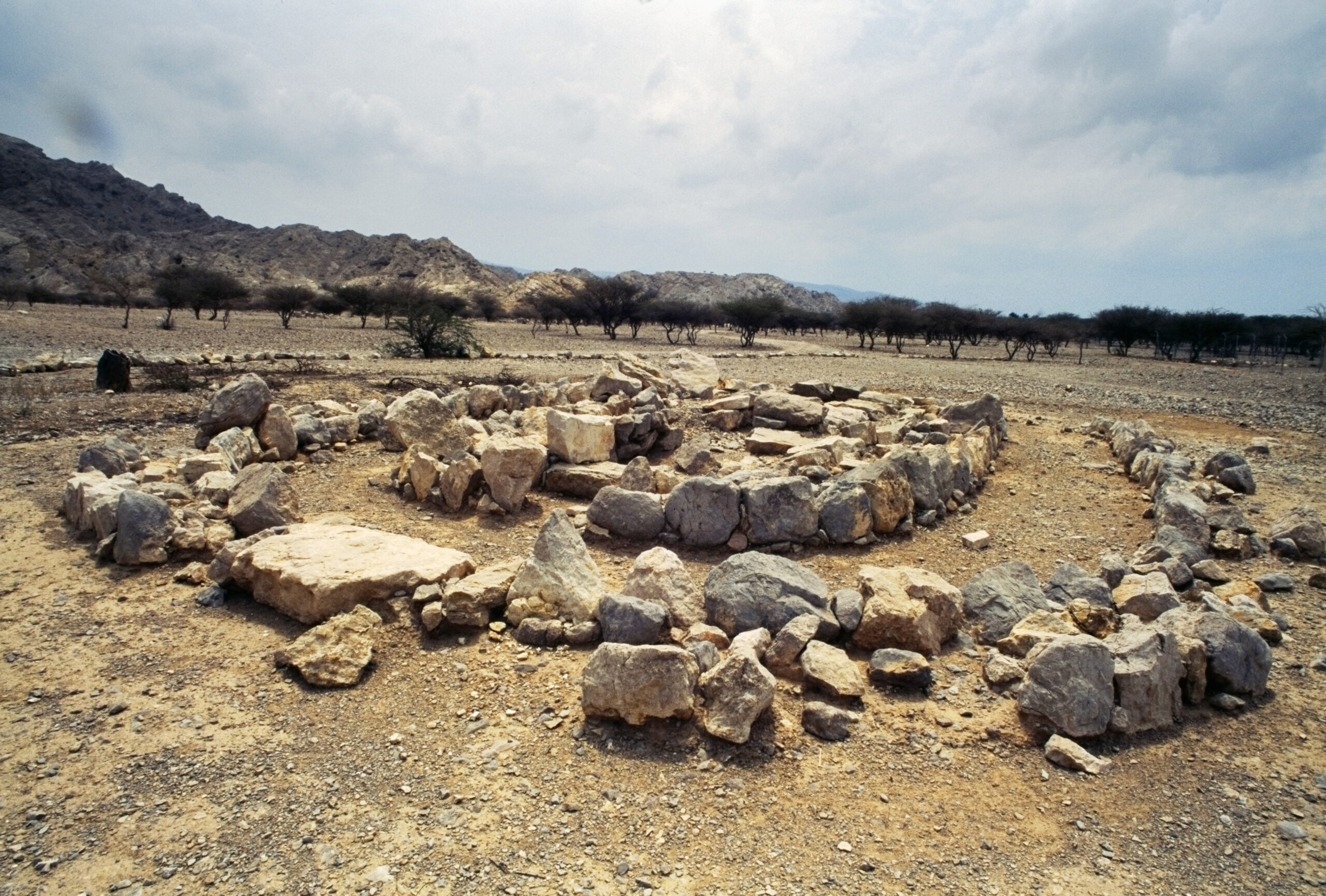
Tomb from the Wadi Suq Period in Shimal, now a part of the UNESCO world heritage tentative list.
Once again, Shimal is a primary point of focus. It is home to hundreds of tombs from the Wadi Suq period and forms the largest cemetery of prehistoric megalithic graves found anywhere in southeast Arabia. In contrast to the Umm an-Nar Period, the largest Wadi Suq tombs are long and narrow and up to twenty-four metres in length. They were communal graves for a minimum of thirty to sixty people and were constructed of local limestone. Built above ground, 150 of these graves have so far been discovered, not just at Shimal, but across the emirate. They consist of one or two chambers, with double-skinned walls and a single entrance located midway down one side. At Shimal, most of the tombs were oriented according to the terrain, preventing rainwater from entering the tombs.
Tomb design varied and ranges from the large communal graves mentioned above to small structures (either rectangular or oval in shape) with double-skinned walling. Large concentrations of tombs have also been found at Dhayah, Khatt, Wadi Ghalilah and Qarn al-Harf, where eight monumental Wadi Suq tombs were excavated in 2013. Smaller tombs have also been excavated at Wadi Muna’i. Some tombs have been used over a long period of time and include the addition of an outer-ring chamber that encircles its interior older tomb, with a passageway between the two.
Many of the burial sites have produced a tantalising array of grave goods, including weapons, jewellery and a distinctive range of painted pottery. The latter includes beakers and spouted jars, while jewellery consists of numerous carnelian and agate beads, as well as shell and bronze finger rings, silver earrings and a bronze bracelet. Finely worked animal jewellery in the form of silver and electrum brooches or pendants have also been found in Shimal, Dhayah and Qarn al Harf. Consisting of either single or two back-to-back animals with their tails curled up in a spiral, they provide evidence of an accumulation of wealth, most probably made on the back of trade in copper. Further evidence of this copper trade is the existence in Wadi Suq tombs of pottery from the Indus Valley and Bahrain, silver used for jewellery from Anatolia, and a cubical weight from the Indus Valley Civilisation.
Late Bronze Age (1600–1250 BC)
A number of Wadi Suq settlements continued to be occupied during the Late Bronze Age, including Tell Abraq and Kalba, while much of our understanding of the Late Bronze Age period in Ras Al Khaimah is informed by a settlement in the Shimal area. First excavated in 1986, it was built on the slopes of the Ru’s al-Jabal and developed around a prominent triangular rock. Fortified by a large defensive wall constructed along the edge of the wadi terrace to the south, the settlement has revealed the existence of arish-style housing located on terraced levels above the wadi bed. The discovery of large shell middens to the west of the settlement also suggests that its inhabitants relied on the creek for sustenance, while dates and animal bones provide evidence of farming. During the Late Bronze Age, Ras Al Khaimah was densely settled, evidenced by further archaeological remains found in Ghalilah, Dhayah, Falayah, Fahlain and Khatt.
Although certain aspects of the Late Bronze Age are indicative of a cultural continuation from the Wadi Suq period, pottery from Shimal has revealed a clear division in terms of material culture. Distinctive pottery, for example, includes footed goblets, large and small bowls, as well as small incurving bowls, which are the only painted examples. There is also a noticeable change in weaponry during the Late Bronze Age, with long swords appearing in tombs across the UAE, including at Shimal, where swords of between thirty and sixty centimetres in length have been found. Distinctive short swords – or daggers cast with the blade and hilt in one piece – also appear in the latter stages of the period, as do shaft-hole axes. These short swords continued to be used into the Iron Age and had a flanged hilt that held an organic inlay. Arrowheads appear for the first time as well.
THE IRON AGE
In many ways, the Iron Age (1300–600 BC) is defined by technological innovation, the development of mud brick villages, the appearance of impressive fortifications, and the arrival of foreign powers and influence. It is also defined by the domestication of the camel, which not only made the movement of goods and people across the desert possible, however, it impacted foreign trade thanks to the creation of long-distance caravan routes that linked south-east Arabia with south Arabia and the Levant. This innovation in animal husbandry was to have far-reaching consequences for the region, as would another hugely important Iron Age innovation.
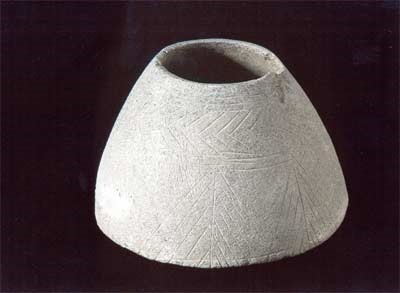
Soft stone vessel from the Iron Age. © RAK National Museum.
Around 1000 BC, a revolutionary new irrigation system known as a ‘falaj’ was invented in southeast Arabia, making it one of the oldest systems of its kind in the world. Composed of a series of underground water channels, it brought water from aquifers along the mountains to low-lying agricultural terrain. Its impact was profound, enabling the distribution of water to a large number of farmers and the cultivation of wider areas of previously arid land. The invention of the falaj system necessitated the development of administrative centres, which led to the formation of increasingly complex communities. Indeed, some degree of centralised political and economic control is evident throughout this period, with a cuneiform inscription from Nineveh in Assyria (in modern-day Iraq) referencing Pade, king of Qade. Pade lived in Iskie (most probably modern-day Izki in Oman) and sent tribute to the Assyrian emperor Ashurbanipal in or around 640 BC.
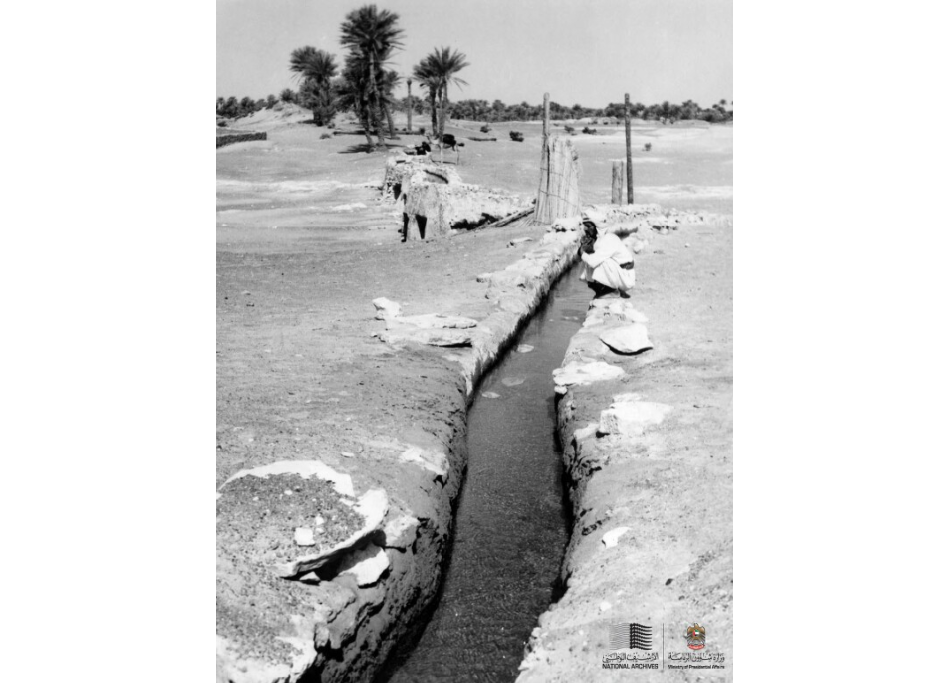
The falaj system was in use in the Emirates for centuries – from its concept around 1000 BC to the late twentieth century. Here is a picture of the falaj from Al Ain in 1954. © National Archives, UAE
The introduction of the falaj system is believed to have led to a considerable increase in the number of settlements across the region. Whereas the second millennium BC was a time of relatively sparse settlement, dozens of Iron Age sites have been identified across the UAE and Oman, indicating a time of considerable settlement expansion. This increase in the number of communities coincided with significant architectural development. While the use of arish-style houses continued, Iron Age sites are characterised by much more substantial buildings, including well-built houses of mud brick or stone. In many instances, these would have been situated behind enclosure walls that demarcated entire communities. All of these developments – the falaj, agricultural expansion, and the construction of more substantial buildings – suggest the population of Ras Al Khaimah and the wider UAE increased significantly during the Iron Age.
In Shimal, remains of a settlement were excavated between the palm gardens and the mountains. Further settlements are known from Ghalilah, Khatt, and Dhayah, where the remains of an Iron Age fortification can be found near the top of a seventy-metre-high hill, which houses a medieval fort. In the emirate’s southern enclave, several large subterranean tombs dating from the Wadi Suq period have been found in the Fashgha and Naslah areas of Wadi Al Qawr and at Wadi Muna’i – all of which were still in use during the Iron Age. These tombs would have belonged to small farming villages that were situated on the wadi terraces and consisted of small groups of houses. These villages would have relied on date palm gardens, kept sheep and goats, and have been in contact with the coastal communities.
At Rafaq, just west of Naslah, the remains of rectangular buildings have been found, as well as circular structures thought to be animal enclosures. On the northern side of the wadi, situated on a high ridge with commanding views of the valley below, also lies the remains of a sizeable fortification. Excavation of the area has revealed the existence of a multi-roomed building, with a flight of steps leading up from the wadi below.
Artefacts recovered from these sites also include painted and undecorated bowls, a vast number of carved and decorated stone containers, and a stone vessel incised with a griffin. The latter is important because it is similar to neo-Assyrian griffins and may have been the copy of an original metal vessel from Assyria in northern Iraq. Not much is known about the later stages of the Iron Age, but there is evidence that the northern emirates and the eastern coastline of what is now Oman became part of Maka, a province of the Achaemenid Empire.
THE LATE PRE-ISLAMIC PERIOD
The end of the Achaemenid Empire in 330 BC meant Maka was no longer a Persian province and south-east Arabia was free from foreign political interference – for a time, at least. Although the Achaemenid Empire had been defeated by the armies of Alexander the Great, the Greeks did not establish their dominance over this region. The Parthian Empire, which emerged in 247 BC, would become a major political and cultural power, but the exact extent of its influence in Ras Al Khaimah during the centuries leading up to the arrival of Islam is unclear.
What is certain is that by the fourth century BC the large number of sites that characterised the Iron Age had shrunk dramatically. Why this was the case is unclear, with very few sites at all dating to the last few centuries BC. Of the sites that do date from this period, Mleiha in the interior of Sharjah is by far the most important, followed by Ed-Dur on the coast of Umm Al Quwain. The former has revealed a wealth of archaeological information, including botanical remains that provide evidence of the cultivation of wheat, barley and dates; the first appearance of individual monumental graves; the production of coins modelled on the issues of Alexander the Great; and pottery from as far afield as Rhodes and Greece. The latter, meanwhile, shows wide-ranging trade connections yielding a single gold coin of the Roman emperor Tiberius; six bronze Characene coins; a bronze coin of the Nabataean king Aretas IV; and early evidence of pearl diving, which was already economically important. This includes a lead bell-shaped pearl diver’s weight with an iron loop on top for the attachment of a rope. As with Mleiha, many of the tombs at Ed-Dur give the impression of substantial wealth.
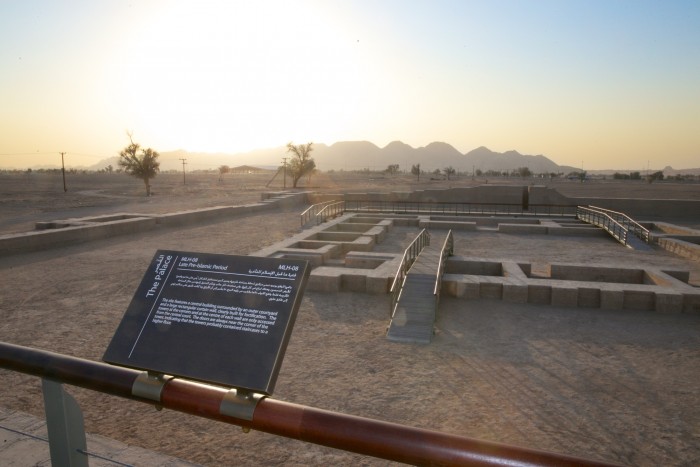
Showing a Pre-Islamic Palace, Mleiha, Sharjah. © Mleiha Archaeological Centre.
Other than Mleiha and Ed-Dur, very few sites have been discovered in the UAE that date to this period, aside from Kush in northern Ras Al Khaimah. Dating from the late pre-Islamic period through to the Islamic era, the site has produced fragments of at least four Roman glass vessels. Otherwise, there is a scarcity of evidence from the Hellenistic and Parthian Period (300 BC to AD 300), although some sites, including individual tombs and some reused old graves, have been found at Shimal, Asimah and Wadi Muna’i.
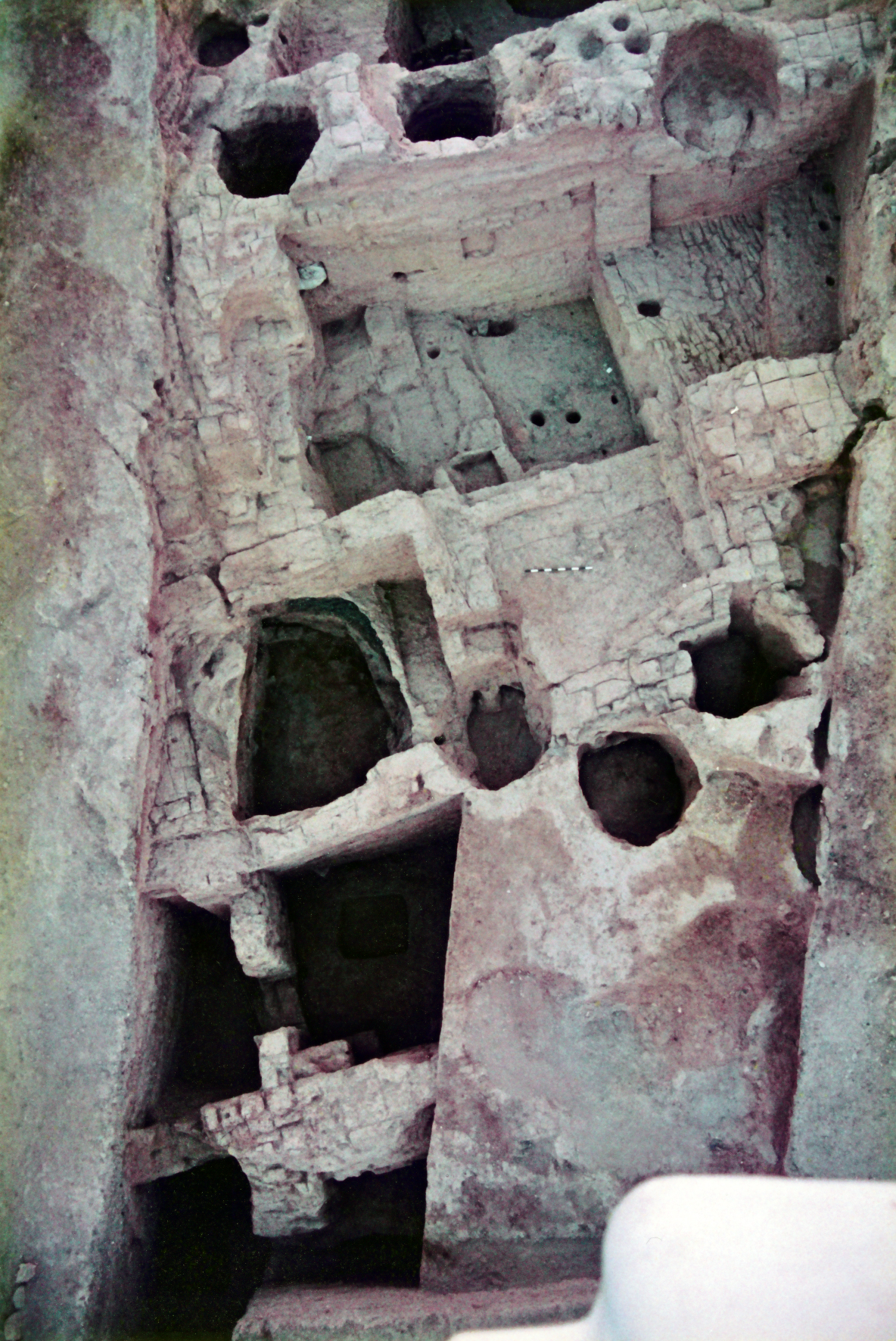
Archaeological digs in Kush indicate human occupation in the area from the fourth century.
The final era prior to the arrival of Islam is the Sasanian Period (AD 300–632). According to the Karnamag-e Ardashir-e Pabagan (The Book of Deeds of Ardashir son of Pabag), which recounts the story of Ardashir, the founder of the Sassanid dynasty, the Sasanian Empire fought the men of Mazun (of which Ras Al Khaimah was a part) from the outset. Although Persian rule was probably limited to a military presence along the coast, it is now clear that a sizeable portion of Ras Al Khaimah was occupied by the Sasanian Empire during the latter part of their rule. Nowhere is this more apparent than at Kush, an archaeological tell lying within the Shimal plain. Excavations carried out by the Department of Antiquities and Museums have revealed a large, probably public building complex and a variety of artefacts. These include a coin of the Sasanian king Kavad, which was made sometime between AD 507 and 519, and a Sasanian seal made of carnelian and decorated with a griffin motif. There is also evidence in Khatt of a Sassanian period settlement during the fourth and fifth centuries, based on two small mounds that have been identified as dating predominantly from the Sasanian Period. The Sasanian Empire would remain in control of the coastline of Ras Al Khaimah for 200 years, until the arrival of Islam and their subsequent defeat at the hands of the Azd kings of south-east Arabia.
REFERENCES
Benoist, Anne: The Iron Age Culture in the United Arab Emirates, between 1100 BC and 250 BC
(2008). Read More
Beech, Mark; Kallweit, Heiko: A Note on the Archaeological and Environmental Remains from Site JH57, a 5th-4th Millennium BC shell midden in Jazirat al-Hamra, Ras al-Khaimah (2001). Read More
Carter, Robert: Defining the Late Bronze Age in Southeast Arabia: ceramic evolution and settlement during the second millennium BC (1997). Read More
Donaldson, Peter: Prehistoric Tombs of Ras al-Khaimah (1984).
Gregoricka, Lesley: Human Response to Climate Change during the Umm an-Nar/Wadi Suq Transition in the United Arab Emirates (2016). Read More
Kennet, Derek: Archaeological history of the Northern Emirates in the Islamic Period: An Outline (2012). Read More
Kennet, Derek: Kush: A Sasanian and Islamic-period Archaeological tell in Ras al-Khaimah (1997). Read More
Magee, Peter: The Archeology of Prehistoric Arabia (2014). Read More
Mery, Sophie: Wadi Suq Fine Wares From Shimal and Hili Sites (United Arab Emirates) A Technological and Provenience Analysis (1991). Read More
Potts, Daniel: In the Land of the Emirates: The Archaeology and History of the UAE (2012). Read More
Velde, Christian: The Landscape of the Middle Bronze Age in the UAE – Where did people live? (2009). Read More
Vogt, Burkhard; Franke-Vogt, Ute: Excavations of the German Archaeological Mission in Ras al-Khaimah, U.A.E.: a preliminary report (1987). Read More